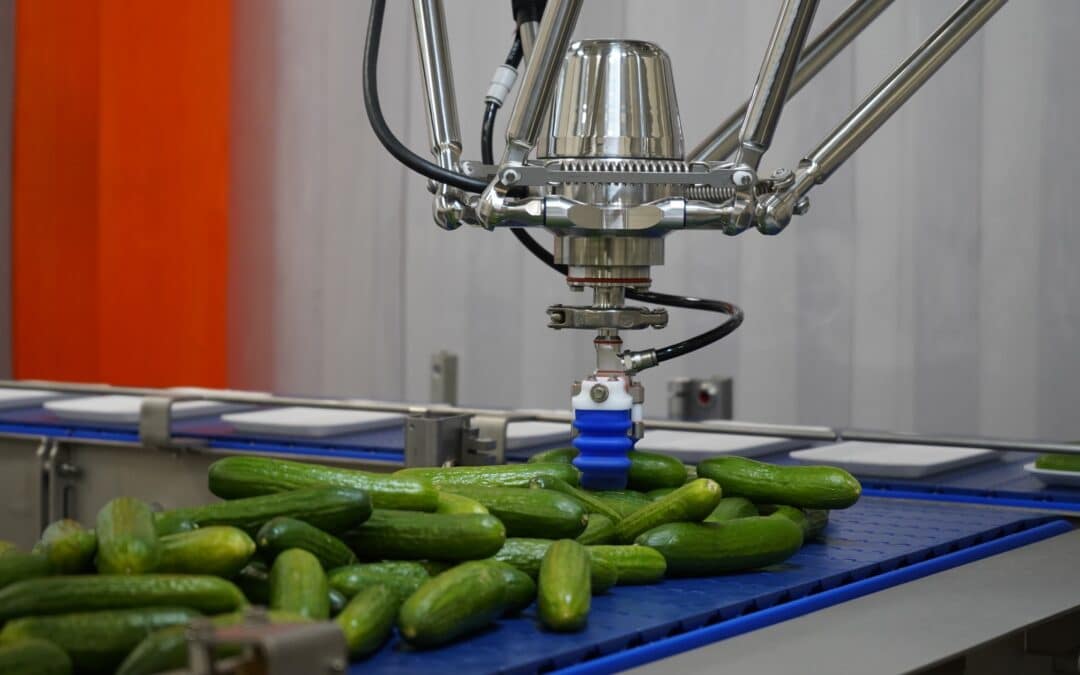The need to control costs and deal with labor shortages is driving the food industry toward increased automation. There are five facts about automation that can help you decide if and how you should automate your operations.
Industrial automation … incorporating robots in production processes … is common in many sectors. We’ve all seen videos of frenetic activity on vehicle assembly lines with dozens of robots welding, grinding, and performing many other tasks. You probably haven’t seen robots gently handling baked goods, precisely packing delicate chocolates, or manipulating whole slabs of pork bellies.
Automating food production isn’t as visually dynamic as heavy industrial tasks. And robots haven’t been as widely accepted in the food processing industry. But constant pressure to reduce cost and deal with labor shortages has greatly increased the interest in how automation can be put to work in the food-production industry.
Automation is successfully being used in many aspects of food production, particularly ready-to-eat products. But there remain many misconceptions about the benefits and challenges of automating food production.
Here are five facts that will help managers in food-production facilities identify good opportunities for automation in your operations.
1. You will be surprised by the range of operations that can be automated
Production managers often assume that robots can be used only in applications where durable items or products are precisely positioned or oriented so the robot can grab them. In fact, today’s vision systems and software combined with flexible end-of-arm tooling have amazing capabilities to identify, singulate, and grip delicate, in-process ingredients and products regardless of their location or orientation.
Soft Robotics’ mGripAI™ solution combines 3D vision, artificial intelligence, and soft gripping to provide end-of-arm tooling that can identify and pick individual items from tubs or unorganized piles, lift single baked goods from a conveyor, or – the Holy Grail of food automation – separate chicken breasts from piles and orient them right side up in a package.”
Retailers and distributors are increasingly asking food producers to provide variety and rainbow packs to their end customers. This is an area where robots excel: picking items from multiple bins, totes, or belts and placing them in trays or packages, automating the packing process and creating items ready for display on store shelves.
2. You can reduce your costs
Cost reductions come in several forms. The most obvious savings relate to labor, since robots typically greatly outperform and outproduce human labor.
Because robots are less prone to error, you also reduce the costs of damaged food items being produced as well as poor-quality product being shipped. Vision systems can easily identify macro defects: a missing stick in a corn dog or icing on a pastry, the number of pieces in a tray, carton or case, mis-shaped or mis-sized product, and many other defects.
Product is often scrapped when one station or operation goes offline and in-process product is run off into totes as waste. Depending on the product, it’s often possible to include a recirculation path that returns the product to the line rather than discarding it. This path can include buffers, temporary storage areas where the product can wait until the line is back in operation, further reducing waste.
The final significant savings is reduced floor space. A single robot typically produces the same output as several human operators, which means having more compact production lines that require a smaller footprint.
3. You can simplify your staffing
Many, possibly most, food-production jobs are highly repetitive and require less skills. That makes finding enough team members to fully staff production lines a challenge, especially in today’s labor market. Keeping those team members is an additional challenge. High turnover means wasted time and money in bringing new people up to speed.
Those repetitive jobs are where robots excel. On the other hand, robots are incapable of instantly shifting between tasks, resolving production issues, or identifying process improvements. Automating routine tasks enables you to reallocate team members to functions where they will have more variety, job satisfaction, and potential for professional growth. That makes it easier to both recruit and retain team members.
4. You can start small
Your automation integrator may be able provide a total automation solution that takes your product from where it exits the freezer, oven, or fryer to final packaging. But you don’t have to take a giant, all-at-once leap into automation.
It’s easy, and perhaps prudent, to ease into automation with a small-scale project. There are almost certainly some steps in your process that offer especially high-value automation opportunities. But when taking this step-wise approach, it’s essential that you start with the big picture in mind. Your integrator should develop an overall plan for your full potential automation system, and then work backwards from there to your small, initial implementation. That ensures a seamless path on your automation journey, building on your early successes and avoiding islands of automation that can’t readily be incorporated in future expansions.
5. You can improve food safety and quality
One of the roadblocks to automating food production was the difficulty of maintaining hygienic conditions. Industrial robots were built for industrial environments, with little concern about keeping a clean and sanitary environment.
Today, however, there are robots made for the food industry, like the FANUC stainless steel delta robot for picking and packing primary food products (DR-3iB). These robots are hygienic, meeting all USDA and FDA food safety standards, including IP 69K. Relying on these robots reduces one of the primary sources of food contamination: human operators. And it facilitates washdowns and other sanitation practices.
Another aspect of improved food safety are automated clean-in-place systems that are connected to the automation. These systems, if designed correctly, can automatically clean themselves and the immediate area around them rather than requiring operators to manually clean them. One example is a production facility that relies on vacuum grippers to pick and place product on the first and second shifts. On the third shift, when production is stopped, the system reverses pressure in the system, effectively blowing out any debris and cleans the system.
An experienced automation provider is critical to success
There are many integrators able to help you automate your operations, but choose your automation partner carefully. Automating primary and secondary packaging lines is far different than positioning parts in a machine tool. Experience in the food industry is invaluable.
Make sure your integrator takes a whole-system approach rather than focusing on one step or station in your production process in isolation. As mentioned, you may want to start with a small automation project, but be certain it will fit your future line requirements.
Ask potential integrators about laying the groundwork with your team for a successful deployment. The introduction of robots typically fills team members with dread. Skilled integrators can help you with the human aspect of bringing robots into your facility, training team members on their new responsibilities and enhanced role in production.
Finally, it’s important to determine what post-commissioning support the integrator will provide. Do they provide technical support, maintenance, and spare parts?
A tremendous opportunity to collect a wealth of information on automation is coming up at Pack Expo, September 11-13 at Las Vegas. The show encompasses packaging and processing solutions, but there are specific areas of focus on baking & snack, confectionery, meat/poultry/seafood, and other food sectors. If you have any questions or would like to discuss your needs, our SPA experts can be located in the KMT Waterjet booth #N-9339.



Recent Comments